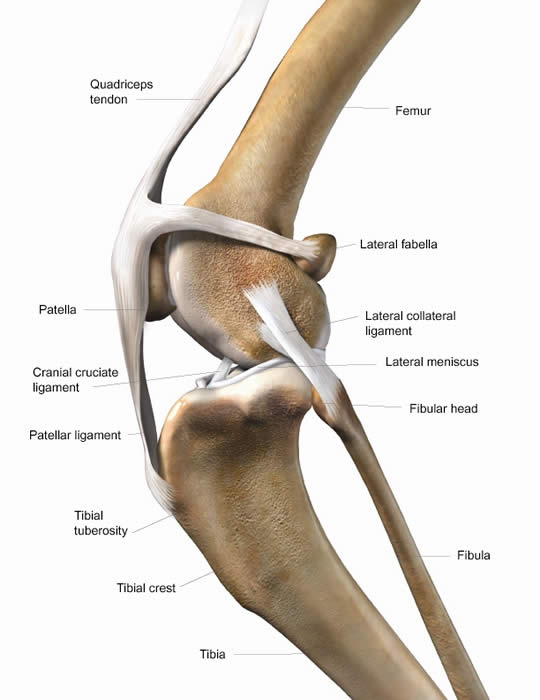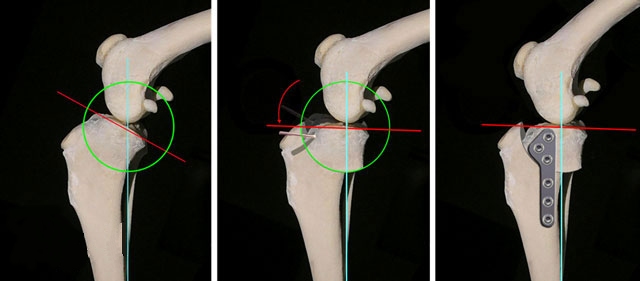Stifle Joint Surgery
Part two of two. Part two discusses modern treatment options available to pet parents.
With the basic anatomical issues covered, it is time to explore what treatment/surgical options are available to pet parents to alleviate stifle joint problems.

TREATMENT
(remember: I am not a surgeon! Please discuss your pet's case with your vet or specialist and use this post to prepare you to better understand the options available.)
CCL (ACL) Reconstruction
With each passing year, surgical treatment options for pets grow, often mimicking techniques used on humans. Figure 1 is provided for reference and is an example of a healthy stifle joint

(source: balkanvets.com)
There are four options for cranial cruciate ligament reconstruction. Two are very invasive in that whole sections of bone are cut and plates inserted. The other two are less invasive and require only screws and small bone tunnels.
TPLO
The TPLO (tibial plateau leveling osteotomy) procedure was developed for larger or more active dogs. Though complex and invasive, this technique can result in a quicker overall recovery and a greater range of motion in the stifle joint. There have been claims but no conclusive proof that TPLO also reduces the likelihood of severe arthritis in the joint.
TPLO does not replace the damaged ligament, instead it changes the shape of the tibia so that the femur no longer slides down slope and unconstrained by a ligament (see figure 2). 
Source: vetpedia.net
TPLO surgery cuts out and rotates a bone segment from the top portion of the tibia (“radial osteotomy”). This piece is then reattached to the tibia with a metal plate. The angle of rotation varies depending on the original tibial plateau angle (TPA) and is chosen for maximum stability, usually 90 degrees.
This alteration greatly reduces the cranial thrust that causes stifle instability and pain. Because bone is cut, the initial recovery period is similar to that of a broken bone, approximately 8-12 weeks.
Though most TPLO surgeries are successful, post surgical complications can be more serious than other techniques. These include cracking of the bone around the plate attachment screws, tibial surface fractures, meniscus damage and increased stress on the patellar ligament. One large study showed a 3% rate of 'major' complications from TPLO surgery. In general, care must be taken in evaluating any animal studies as incidents are often self-reported; there may be a tendency to under report poor outcomes. In addition, there can be differences in what is considered a major vs. minor complication.
TTA
TTA (Tibial Tuberosity Advancement) is a different technique that has also been recommended for medium to large breeds. The TTA procedure cuts and moves the top of the tibia in a manner that allows the patellar tendon to be positioned so that shear forces in the stifle joint are neutralized. The cut portion of bone is held in proper alignment with a plate and spacer (figure 3).
Source: St. charles Animal Hospital/ttpasurgery.com
Figure 3

The TTA recovery period is said to be faster than TPLO but the long term outcomes are similar. Though the initial recovery time is similar to TPLO at 8 weeks, most dogs are expected to achieve full load bearing capacity in only 16 weeks. Some specialists are now recommending TTA over TPLO, though TTA is not ideal for every dog and is definitely not recommended for breeds that have a very steep tibial plateau.
TTA complications are similar to that of TPLO though there may be a slightly higher incidence of patellar and meniscus problems. Some specialists now recommend meniscal release (the connection of a part of the meniscus is cut) to alleviate some meniscus complications. Though incidents of complications from TTA surgery appear higher than TPLO in the limited studies performed, this could be partially due to fewer statistics (less dogs) and partly due to surgeon unfamiliarity with the technique – it is much newer than TPLO.
Extracapasular
There are two “extracapasular” - outside the joint – techniques in common use. MRIT (modified retinacular imbrication technique) and “Tight Rope” (TR) are similar to the common human reconstruction methods (using a graft to replace the damaged ligament). Instead of using a piece of a tendon, the graft material used is a heavy suture.
Extracapasular procedures were often used on smaller or sedentary dogs and not recommended for large breeds as the sutures could rupture prematurely. However, recent advances in synthetic materials allows both techniques to be used on most dogs. Only for dogs with a very large TPA are other techniques, such as TPLO, more advisable.
TR
Here I will focus on the TR method as it appears to be supplanting the MRIT technique. I was also able to speak with Dr. James Cook, the man who created this patented technique. Figure 4 depicts the completed procedure.

Source: Arthrex Vet Systems literature
As you can see from the image, the suture wraps around the front of the stifle joint, passing through two small (3.5 mm) tunnels drilled into the bones. The recommended suture is FiberTape or similar material. FiberTape is a very strong material, about 2 mm wide, made from long chain polyethylene. FiberTape is also used in human orthopedic surgery, such as shoulder reconstructions. The suture is tensioned appropriately using a tensionmeter.
Recovery time is about 8 weeks, primarily to allow the formation of fibrous tissue across the joint. In a large study (over 2,500 cases) of data submitted by over 40 surgical centers, about 5% of cases reported complication from meniscal tears, 3% had continued instability and under 2% developed serious infection. Infection can be the result of improper handling of the suture material by the surgical staff.
I had a bit of confusion about the extracapasular procedures in general and TR in particular. My conversation with Dr. Cook was able to clear up some important points.
First, I wanted to be certain that this procedure really was OK for larger breed dogs and not just those under 40 or so lbs. Indeed, there are a number of high strength tapes on the market that have been used in dogs up to 200 pounds and even a 400 lb. chimpanzee. Weight is no longer a concern.
One thing that really baffled me while researching these techniques was that the sutures are said not to be permanent. This is a marked deviation from the typical human ACL reconstruction where the graft is expected to last many, many years if not a lifetime. I asked Dr. Cook about the longevity of the graft:
To try to be really clear, I need to explain the various aspects. First, the materials used for these types of procedures including TR are non-absorbable materials so they are all permanent synthetic materials in the dog unless removed. The "procedure" is designed to "last" for the life of the dog if successful. So, the temporary part is that the synthetic suture material and fixation implants, TR in this case, are designed to hold the knee stable enough for long enough to allow the fibrous healing tissue (periarticular fibrosis) to become the permanent,functional stabilizer of the knee.
Another way to think about this is that the TR is used to allow the body to effectively heal to restore knee function when it otherwise could not. This time period is at a minimum 8 weeks and ideally would be more like 6 months of effective stabilizing by the implants so that the healing tissue is strong and stable. TR has been shown to be capable of this - many others have been shown not to be or not tested at all.
This prompted my follow-up question as to why no grafts are permanent like the ones for pet parents. Again, I defer directly to Dr. Cook's explanation:
Human ACL reconstructions use intra-articular (inside the joint) anatomic replacements of the ACL with tendon autograft or allografts such that the biologic replacement (graft) can recellularize, revascularize and function as an actual ACL replacement. These have not worked well in dogs, despite lots of research and clinical trials, because dogs CCLD is a degenerative process such that the joint is a hostile environment for these types of grafts.
Add to that the fact that dogs have a much higher tibial slope than humans and cannot be nearly as well controlled or rehabbed in the immediate postop period and this causes these grafts to consistently fail in dogs. That is why people do either anatomy altering highly invasive procedures like TPLO and TTA, or synthetic extra-articular/extracapsular (outside the joint) stabilizing techniques to allow functional scar tissue to form.
So in the case of our pets, what is really happening in all of these surgeries (including TPLO/TTA) is the stabilization of the stifle joint for a period of time long enough to allow this fibrous scar tissue type material to develop and become stronger. Ultimately, the stability of the stifle joint will come from the periarticular fibrosis, regardless of whether TR, TPLO or TTA is used. TPLO and TPA also attempt to mitigate the effects of cranial thrust on the joint by reducing the TPA but at the expense of a much more invasive procedure (and potentially more serious complications and cost).
Meniscus Damage
As explained earlier, in many cases of ligament tears there will be meniscus damage (order 70% on the medial side). Today, though still controversial, there is increased recommendation of partial meniscectomy, where only the damaged portions are removed in an attempt to preserve some function. The downside to this procedure is the remaining meniscus may still be subject to future fraying (causing discomfort), the upside is potentially less severe arthritis. The surgeon will need to closely evaluate your pet's specific situation to determine what is the most appropriate course of action - nothing, partial or complete removal.
Luxating Patella
Corrective surgery for luxating patellae is recommended for those cats and small dogs that have severe conditions. There are a number of techniques that may be performed individually or combined and all have had very successful outcomes. For those pets with only minor shifting, surgery can often be avoided or deferred until clinical signs develop.
Recovery
Whenever a pet suffers severe ligament damage, muscle atrophy is a big concern. This is true both before and after surgery while activities are prohibited or greatly reduced. Pet parents should inquire with their specialist if hydro therapy (underwater treadmill) is available for their dog. Unfortunately, cats will probably not be at all receptive to this type of exercise!
The post surgical recovery period may be the most difficult (and painful) time for both pets and pet parents. The first few days home your dog or cat will probably be in pain, especially if joints are cut. Your vet will give you medications for this but as always, the trick is in the administration. Pets are also not likely to be interested in food for 24 to 48 hours.
As the pain wears off, the biggest post operative concern is that your pet will cause damage to the reconstruction by excessive activity before bones and grafts are properly healed. Unfortunately, the recovery period for pets can be problematic as they just do not understand “Don't run around! Don't chase that!”
Activity will be strictly curtailed to just those the surgeon allows. Running and jumping are definite no-nos as will be racing in circles with children or other pets. Many surgeons recommend that your pet be crated during the times you cannot supervise their activity.
As healing continues and subsequent physical examinations confirm, more activities at greater durations will be added. It is crucial that pet parents follow up with these exams, especially for TPLO and TTA that involve bone cuts.
To reduce the chance of a bad outcome, plan your outdoor walks to minimize interaction with other pets. Even though they may seem to be moving normally and pain free at four or six weeks (or sooner!), resist the temptation to let them have a run, no matter how much they plead with you! Homes with large numbers or very steep stairs may also present challenges.
Conclusion
As human surgical methods advance, so to do those available to our pets. Regrettably, the downside is that surgical costs can also be very expensive. However, materials that were not available in the past, such as FiberTape, make techniques previously limited accessible to more pets and at lower cost to their parents.
Obviously, every injury is unique so I can't "recommend" one procedure over the others universally. However, my own personal inclination would be to select one of the extracapasular techniques absent a very specific reason such as high TPA.
Beyond the substantial cost savings (TPLO and TTA can run over $5,000), there is no concrete evidence that one method produces more statistically signficant favorable outcomes. When they work, they all seem to work well. However, I am always concerned with the risks associated with surgery and to my mind, erring for the less invasive technique is to be preferred when all other criteria are about equal.
For those pet parents who do not live in a major metropolitan area, osteo clinics may be few and far apart. If this is the case and travel out of the area is not practical or financially feasible, it is better to select the method the resident surgeon is most comfortable performing. Like humans, not all pet surgeons perform all available techniques on a regular basis. Practice makes perfect should not be discounted.
In some cases, it may be possible to avoid surgery all together. Pet parents and their vet will need to consider closely their dog or cat's age, activity level and the types of obstacles they need to navigate on a daily basis (hills, stairs, etc.) For older, sedentary pets who are not in frequent or significant pain, rest and other non-surgical assistance may be the best path forward.
Finally, I would remind pet parents that keeping their dog or cat at their ideal weight can go a long way to reducing the chances of a significant CCL injury, whether from genetic predisposition or athletic activity.


